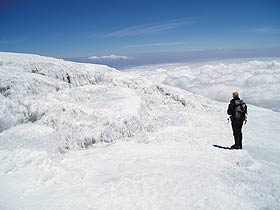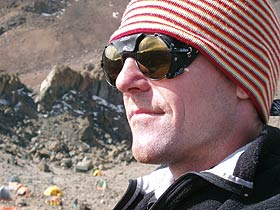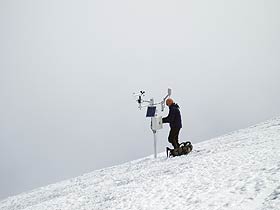
 Dr Nicolas Cullen:
Dr Nicolas Cullen:
Glaciers can tell us something about climate change – they are useful indicators."
Sticking thousands of metres up into the atmosphere, it is little wonder that climatologists are looking to mighty Mount Kilimanjaro and its unique glaciers to act like climate change sensors.
Dr Nicolas Cullen (Department of Geography) began studying the 5,895 metre giant during postdoctoral work at the University of Innsbruck in Austria, working with Professor Georg Kaser and Dr Thomas Mölg.
Kilimanjaro is interesting because it is the highest free-standing mountain in the world and the highest point in Africa. It penetrates into the mid-troposphere and you can detect variability in the climate, not only near the surface, but well up into the atmosphere."
 Cullen says field measurements and data from automatic weather stations on Kilimanjaro, in conjunction with atmospheric modelling, are used to determine the climatic controls on glacier behaviour.
Cullen says field measurements and data from automatic weather stations on Kilimanjaro, in conjunction with atmospheric modelling, are used to determine the climatic controls on glacier behaviour.
Glaciers can tell us something about climate change – they are useful indicators. If you can unravel those processes in the present, you're in a position to say something about both the past and future – and that's the most exciting part."
But Kilimanjaro is also the focus of intense debate: some scientists see the glacial retreat as being driven by global warming, but Cullen believes it is something more complex than just a rise in air temperatures.
If you look at the physical processes responsible for glacial retreat on Kilimanjaro it becomes evident that moisture variability controls the observed retreat as much, or more, than any change in air temperature."
This view has been reinforced in research papers he and his Austrian colleagues have published over the past year.
One of them, which reconstructed climate back to the late 19th century, demonstrated that precipitation rates had the greatest influence on glacier mass, while a second paper produced evidence that suggested glaciers on the mountain have come and gone cyclically over relatively short time periods (a few hundred years) in response to changes in snowfall rather than being persistent features over the past 12,000 years.
 Cullen says this mountain should not be used as a flagship for global warming because the ice masses are being starved of snowfall and depleted by solar radiation rather than being cooked" by high air temperatures.
Cullen says this mountain should not be used as a flagship for global warming because the ice masses are being starved of snowfall and depleted by solar radiation rather than being cooked" by high air temperatures.
While Kilimanjaro's height and tropical location provide unique data, students are also being encouraged to study glaciers here, says Cullen.
I think New Zealand glaciers can also be used to help unravel this issue of climate change – but we can still do a better job."
Funding
Austrian Science Foundation Humanities Research Grant